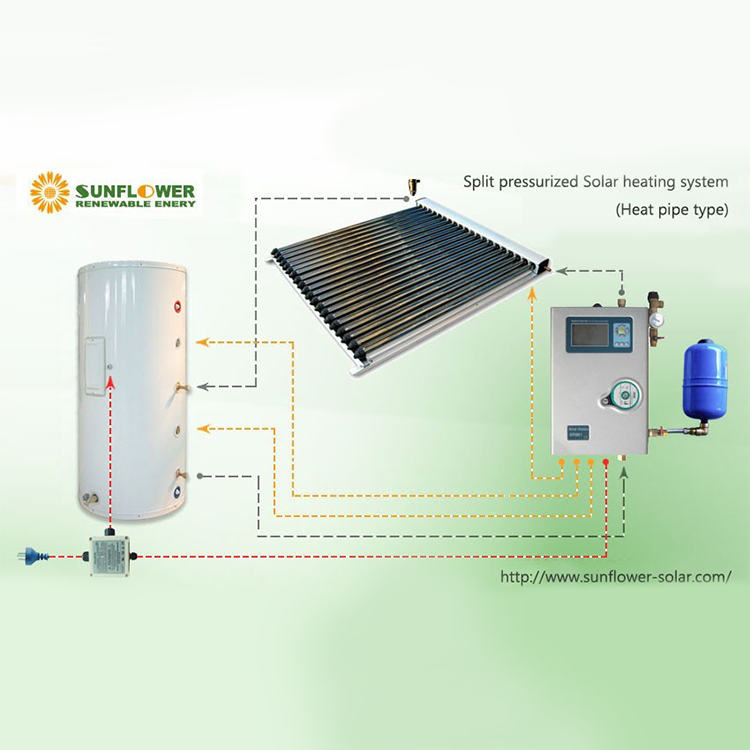Views: 23 Author: Site Editor Publish Time: 2021-12-07 Origin: Site

If you are trying to determine if solar hot water is right for you, understanding the installation requirements and process will help you get a better handle on the scope of your home's solar hot water project. As with any complex mechanical equipment, it is important to work with a reputable professional installer to ensure your solar hot water installation is done correctly.
Step 1: Installing the solar collectors
In most solar hot water installations, the first step is to install the solar collector on the roof. Most solar hot water collectors are similar in shape to photovoltaic solar panels and can also be placed flat on the roof.
In order to install the collector correctly, your installer may need to remove part of the roof tiles and expose the flat tar paper that acts as a protection between the roof tiles and the roof deck. Once a suitable surface has been found or created, the collector is then manoeuvred into place and screwed directly into the roof deck and rafters below.
Step 2: Installing the storage tank and heat exchanger
Next, your collector will need a storage tank so that they can deliver the heated antifreeze to it. The storage tank and the heat exchanger contained within it are the largest part of the solar hot water system and are usually located in the basement or utility closet, where they can be accessed via the water pipes and antifreeze tubes.
If you are replacing a gas-powered tank, this step is essentially a replacement project. You can choose to install as many tanks as you like, depending on the size of your house and the amount of water you use. In addition, at this point you will need to make room and install a back-up tank to be powered by electricity or gas when the solar hot water runs out.
Step 3: Installing the antifreeze pipework
To connect your collector to the heat exchanger and storage tank, your installer will connect flexible piping from your roof to your new storage tank or multiple storage tanks. The antifreeze flows from a pipe on the collector side and then to the heat exchanger. An additional line will be installed to connect the end of the heat exchanger back to your roof so that the fluid can circulate. If you have multiple collectors, additional piping will be installed to connect them.
Installing these antifreeze piping paths requires access to your roof, which almost always means cutting several holes in the roof slab - one for the pipe that sends the antifreeze back and one for the pipe that sends it back to the collector. These holes do not need to be larger than the diameter of the pipe and can easily be covered with insulation and replacement shingles when the installation is complete.
Step 4: Installing the delivery pipe
As with antifreeze, the water needs to circulate through the new solar hot water installation. The water transfer line, usually in the form of copper pipes, needs to be connected from your storage tank to the rest of your home.
Your home may already be set up with a suitable water supply line. The only work your installer will have to do is to remove the water connection from the old hot water unit and connect it to the new storage tank and back-up system.
As an important side note, you will also need to consider the back-up hot water infrastructure. If your back-up unit is an electric water heater, you will need to install the correct wiring. If you plan to use natural gas to back up your solar hot water, you will need to connect the natural gas line to the backup storage tank.
Step 5: Installing the control system
Two temperature sensors must be connected by wire and installed in the hot water system. One sensor should be connected to your collector and one to the bottom of your storage tank. These will be connected to the central control system and provide guidance on when to circulate the antifreeze. For example, there is no reason to circulate the fluid if the temperature in the collector is lower than the temperature in the tank - in fact, doing so will cool the water.
Step 6: Insulating the system
Once all the components are in place, the final step in any solar hot water job is to insulate each component. Your installer will plug the holes in the roof, insulate the pipes and double-check that the connections between the components are sealed. Any energy lost along the pipework or in the storage tank itself will result in a loss of savings, so it is vital that the system is properly isolated.